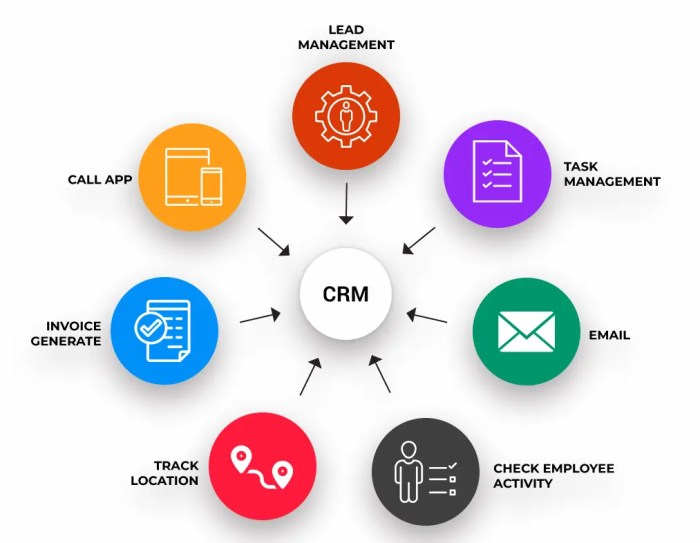CRM software with easy data migration is crucial for businesses seeking to streamline their operations and improve customer relationships. Successfully migrating data to a new CRM system requires careful planning and execution, encompassing data cleansing, robust mapping capabilities, and secure transfer protocols. This comprehensive guide explores the intricacies of this process, addressing common challenges and offering solutions to ensure a smooth and efficient transition.
From understanding the characteristics of a user-friendly data migration process to mastering data cleansing techniques and leveraging API integrations, we will delve into the essential features of effective CRM software. We’ll also examine data security protocols, post-migration validation, and optimization strategies, providing practical insights and real-world examples to empower you with the knowledge needed for a successful CRM data migration.
Defining “Easy Data Migration” in CRM Software
Efficient data migration is crucial for a successful CRM implementation. A smooth transition minimizes disruption and maximizes the benefits of the new system. This section defines what constitutes “easy” data migration in the context of CRM software, highlighting key characteristics and contributing factors.
Characteristics of a User-Friendly Data Migration Process
A user-friendly data migration process within a CRM system is characterized by its intuitiveness, efficiency, and minimal disruption to ongoing business operations. Users should find the process straightforward, with clear instructions and readily available support. The system should handle data transformation and mapping effectively, reducing manual intervention and the risk of errors. Importantly, progress should be transparent and easily monitored.
Key Factors Contributing to Smooth Data Migration
Three key factors contribute to a smooth data migration experience: robust data mapping tools, automated processes, and comprehensive data validation checks. Effective data mapping ensures accurate data transfer between systems. Automation reduces manual effort and the potential for human error. Thorough validation ensures data accuracy and completeness after migration.
Automated vs. Manual Data Migration Methods, CRM software with easy data migration
Automated data migration utilizes software tools to transfer data automatically, minimizing manual intervention. This approach is generally faster, more accurate, and less prone to errors. Manual data migration, on the other hand, involves manual data entry and manipulation, which is time-consuming, error-prone, and resource-intensive. Automated methods are highly preferable for larger datasets.
Data Migration Capabilities of Popular CRM Platforms
Popular CRM platforms like Salesforce, HubSpot, and Microsoft Dynamics 365 offer varying data migration capabilities. Salesforce provides robust tools and integrations for efficient data migration, while HubSpot emphasizes user-friendly interfaces and automation. Microsoft Dynamics 365 offers a blend of both, with strong integration capabilities and user-friendly import/export options. The optimal choice depends on specific needs and existing infrastructure.
Data Migration Challenges and Solutions
CRM data migration often presents challenges. Understanding these challenges and implementing appropriate solutions is crucial for a successful migration. This section details common challenges and provides practical solutions.
Common Challenges During CRM Data Migration
Common challenges include data inconsistencies, data cleansing requirements, data volume, and downtime management. Inconsistent data formats across different systems can hinder migration. Data cleansing is often necessary to ensure data accuracy. Large datasets can slow down the migration process, while downtime must be minimized to maintain business operations.
Data Cleansing Techniques for Data Accuracy
Data cleansing techniques include standardization (e.g., ensuring consistent formatting of addresses), deduplication (removing duplicate entries), and validation (checking data against predefined rules). For example, standardizing address formats ensures accurate geographic targeting in marketing campaigns. Deduplication prevents data redundancy and improves data quality. Validation prevents the migration of incorrect or incomplete data.
Strategies for Minimizing Downtime During Migration
Strategies to minimize downtime include phased migration (migrating data in stages), parallel processing (running the old and new systems concurrently), and utilizing downtime periods (migrating data outside of peak business hours). Phased migration reduces disruption by migrating data incrementally. Parallel processing ensures continuous operation during migration. Migrating during off-peak hours minimizes disruption to daily operations.
Troubleshooting Common Data Migration Errors
A step-by-step guide for troubleshooting might involve: 1. Identifying the error message. 2. Checking data mappings and transformations. 3.
Verifying data source integrity. 4. Consulting documentation or support resources. 5. Implementing corrective actions.
A systematic approach to troubleshooting ensures quick resolution of data migration errors.
Features of CRM Software Supporting Easy Data Migration

Choosing CRM software with features that support easy data migration is essential for a smooth transition. This section highlights key features that simplify the process.
Importance of Robust Data Mapping Capabilities
Robust data mapping capabilities are crucial for accurate data transfer. These capabilities allow administrators to define how data from the source system should be mapped to the corresponding fields in the CRM system. Accurate mapping prevents data loss and ensures data integrity in the new system.
Essential Features Simplifying Data Transformation
Three essential features include automated data transformation tools, data cleansing functionalities, and data validation checks. Automated tools streamline the transformation process, cleansing functionalities improve data quality, and validation checks ensure data accuracy.
Comparison of Data Import/Export Options in CRM Systems
The following table compares the import/export options of four different CRM systems:
| CRM System | Import Options | Export Options | API Integration |
|---|---|---|---|
| Salesforce | CSV, XML, Data Loader | CSV, XML, API | Yes, robust API |
| HubSpot | CSV, Excel, API | CSV, Excel, API | Yes, comprehensive API |
| Microsoft Dynamics 365 | CSV, Excel, Data Import Service | CSV, Excel, API | Yes, extensive API |
| Zoho CRM | CSV, Excel, API | CSV, Excel, API | Yes, well-documented API |
Role of API Integrations in Seamless Data Migration
API integrations facilitate seamless data migration by enabling direct data exchange between systems. APIs provide a standardized way for different applications to communicate, eliminating the need for manual data entry or complex data transformation processes. This ensures efficient and accurate data transfer.
Data Security and Compliance During Migration
Data security and compliance are paramount during CRM data migration. This section details crucial security measures and compliance considerations.
Importance of Data Security Protocols
Robust security protocols are essential to protect sensitive data during migration. These protocols should include encryption, access controls, and data loss prevention measures. Encryption protects data in transit and at rest. Access controls limit access to authorized personnel only. Data loss prevention measures minimize the risk of data breaches.
Ensuring Data Privacy and Compliance

Methods for ensuring data privacy and compliance include adhering to relevant regulations (e.g., GDPR, CCPA), implementing data anonymization techniques, and conducting regular security audits. Adherence to regulations ensures compliance with legal requirements. Data anonymization protects individual privacy. Regular audits identify and address potential security vulnerabilities.
Checklist of Security Measures
A checklist might include:
- Data encryption before, during, and after migration
- Access control restrictions
- Regular security audits
- Data loss prevention measures
- Compliance with relevant regulations
Best Practices for Securing Sensitive Data
Best practices include using strong passwords, employing multi-factor authentication, regularly updating security software, and conducting regular penetration testing. Strong passwords and multi-factor authentication enhance security. Updated software protects against known vulnerabilities. Penetration testing identifies potential weaknesses in the system.
Post-Migration Data Validation and Optimization: CRM Software With Easy Data Migration
Post-migration data validation and optimization are crucial for ensuring data accuracy and maximizing the effectiveness of the new CRM system. This section Artikels key steps in this process.
Techniques for Verifying Data Accuracy and Completeness
Techniques include data comparison (comparing data in the old and new systems), data profiling (analyzing data characteristics), and data reconciliation (identifying and resolving discrepancies). Data comparison ensures data integrity. Data profiling helps identify data quality issues. Data reconciliation ensures data consistency.
Strategies for Optimizing CRM Data
Strategies include data deduplication, data standardization, and data archiving. Deduplication removes redundant data, standardization ensures consistency, and archiving manages historical data effectively. These optimizations improve data quality and system performance.
Workflow for Identifying and Resolving Data Inconsistencies
A workflow might involve: 1. Identifying inconsistencies through data comparison and profiling. 2. Investigating the root cause of inconsistencies. 3.
Implementing corrective actions. 4. Validating the corrections. A systematic approach ensures efficient resolution of data inconsistencies.
Importance of Ongoing Data Maintenance
Ongoing data maintenance is crucial for ensuring data accuracy, consistency, and relevance over time. This includes regular data cleansing, data validation, and data updates. Continuous maintenance ensures the CRM system remains effective and provides accurate insights.
Case Studies: Successful CRM Data Migrations
Examining successful CRM data migration projects provides valuable insights and best practices. This section presents case studies illustrating successful approaches.
Successful CRM Data Migration Project
A hypothetical example: A mid-sized marketing agency successfully migrated from a legacy system to Salesforce. They achieved this through phased migration, extensive data cleansing, and thorough training for staff. Challenges included data inconsistencies and staff resistance to change, but proactive communication and training mitigated these issues.
Data Migration Process in a Specific Industry
In the healthcare industry, a hospital system might migrate patient data to a new CRM system to improve patient care coordination. This would require stringent security measures to comply with HIPAA regulations, focusing on data encryption and access controls. The process would involve meticulous data mapping to ensure accurate transfer of sensitive patient information.
Comparison of Approaches in Two Different Projects
One project might use a phased approach, minimizing downtime but extending the overall migration time. Another project might opt for a “big bang” approach, migrating all data at once, resulting in more downtime but faster completion. The choice depends on business needs and risk tolerance.
Lessons Learned from Successful CRM Data Migration Projects
- Thorough planning is essential.
- Data cleansing is crucial for success.
- User training is vital for adoption.
- Communication is key throughout the process.
- Post-migration validation is necessary.
Last Point
Ultimately, successful CRM software with easy data migration hinges on a multifaceted approach encompassing meticulous planning, robust tools, and a commitment to data security. By understanding the challenges, implementing appropriate solutions, and leveraging best practices, businesses can unlock the full potential of their CRM system, fostering stronger customer relationships and driving business growth. The journey may present hurdles, but with careful navigation and the right resources, a seamless transition is achievable, leading to enhanced efficiency and improved customer engagement.
FAQ Insights
What are the potential costs associated with CRM data migration?
Costs vary depending on factors like data volume, complexity, chosen software, and whether you use internal resources or external consultants. Expect expenses related to software licenses, consultant fees, potential downtime, and staff training.
How long does a typical CRM data migration take?
Migration timelines depend on data size and complexity. Small datasets might take days, while large, complex migrations could extend to weeks or even months.
Can I migrate data from any CRM system to any other?
While many CRM systems offer import/export functionalities, direct migration between all systems isn’t always seamless. Compatibility issues may require data transformation or custom solutions.
What happens if errors occur during data migration?
Robust error handling and rollback mechanisms are crucial. Thorough testing and a well-defined troubleshooting process are essential to minimize disruptions and recover from errors.
